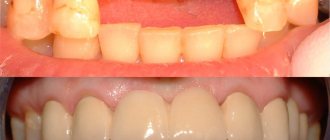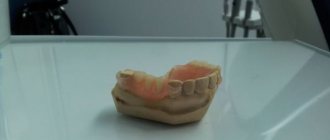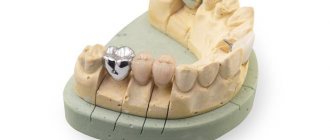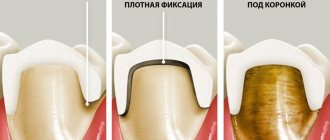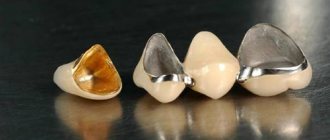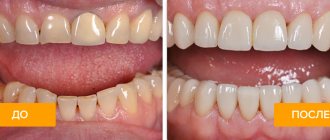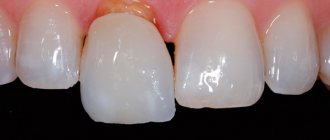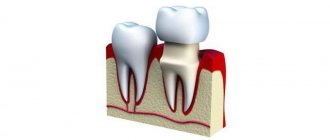The use of metal-ceramic crowns in the prosthetic procedure makes it possible to restore the natural anatomical configuration of a damaged tooth, its functionality, and also its aesthetic appearance. The price of metal-ceramic crowns is quite affordable and therefore this prosthetic option is incredibly popular among most patients in dental clinics.
In the article we will talk in detail about the process of installing metal-ceramic crowns on a tooth: we will consider the types of structures, indications and contraindications for their use, and also find out how much a metal-ceramic crown costs at Vanstom Dentistry in Moscow.
Metal-ceramic crown: design features
An orthopedic prosthesis made of metal-ceramics is a special onlay that is worn during the prosthetic procedure on a tooth that has previously been subjected to the grinding process. The shape of the metal-ceramic crown is identical to the anatomical configuration of natural teeth and repeats it down to the grooves on the tooth surface.
If you look at the photo of the metal-ceramic crown that we posted below, you will see that the base for creating the structure is a solid metal frame and the thickness of its walls can reach 0.5 millimeters. The contours of the frame are similar to the contours of the “native” tooth. On top, the frame base is covered with a layer of ceramics, which matches the color of the natural enamel coating.
Fixation of metal-ceramic crowns is carried out by fixing them on the prepared tooth using a special cementing composition.
Materials for the manufacture of metal-ceramic crowns
Metal alloys
To produce the frame of a metal-ceramic crown in modern dentistry, three types of alloys from different metals are used:
1. Alloys of cobalt and chromium, nickel and chromium. The cost of a metal-ceramic crown made from these alloys will be as low as possible, but it is worth knowing that the listed metals often cause allergic reactions and irritation of gum tissue, and therefore the savings obtained when installing them are questionable.
2. Alloys of palladium, platinum and gold. This material for the production of prosthetics has a number of advantages: hypoallergenic, the ability to create the most natural tone of the prosthetic structure, which is especially important in the process of restoring teeth included in the smile line.
Another type of alloy that is used in the production of metal-ceramic crowns is a mixture with titanium as a base. Titanium alloys are not capable of causing allergic reactions; when used, the risks of rejection and incompatibility of the prosthesis with the tissues of the oral cavity are minimal.
Metal-ceramic crowns
from 8000 rub. More about prices
We have been working since 1994
we are one of the first to open private dentistry in Moscow
Best materials
only new and modern equipment for dental treatment
Free
consultation with a dentist
Payment options
- cash
- plastic cards
- cashless payments
Doctors' experience
- with great experience
- graduated
- conference participants
Types of alloys in metal ceramics
Gold-platinum alloy
The classic version with which orthopedic dentistry began. The first crowns were made from gold at the end of the 19th century.
Nowadays, many materials have appeared that, along with solving the problem of restoring chewing function, are quite durable and at the same time meet high aesthetic and cosmetic requirements. But gold, as a material for the manufacture of frames for metal-ceramic prostheses, is still relevant today.
Only a noble alloy can adhere so precisely to the treated tooth, which practically eliminates disintegration and recurrent caries. Gold almost never causes allergies.
The disadvantage of using a gold alloy is the limitation on the length of the intermediate (located between two supports) part of the metal-ceramic bridge (in the manufacture of metal-ceramic bridges), as well as the price: the cost of such a crown is from 10,000 rubles.
Sometimes, to improve color rendition, on a metal frame cast from other metals. a thin layer of gold is applied, which illuminates through a layer of ceramic mass with a warm yellowish color.
Nickel alloy
Most often, nickel-based alloys are used to cast the frame, which is the most accessible of the metals that can be the basis for metal-ceramics. With nickel alloys there are no problems when casting and fitting in the patient's mouth.
However, despite all the advantages, nickel has a serious drawback. This metal is a strong allergen.
Our body's daily need for nickel is thousandths of a gram, and the production of one metal-ceramic crown requires 2 grams of an alloy containing 1.3 grams of nickel. Thus, the metal is in contact around the clock with the oral mucosa, tooth tissues, and jaw. The result is allergic reactions and weakened immunity.
In Germany, they abandoned the use of nickel in dental prosthetics 10 years ago (as well as stainless steel back in the 30s).
Cobalt-chromium alloys
The most optimal option taking into account biocompatibility and cost.
In cost, they are only 1.6 times more expensive than allergenic nickel alloys. The biocompatibility of the cobalt alloy is 36% (for the gold-platinum alloy it is 42%, and only one’s own teeth are 100% biocompatible), they are non-toxic and do not cause allergic reactions. Cobalt alloys are durable, and metal-ceramic bridges of fairly long length can be made from them.
Chromium alloys are not dangerous; only some of its salts are poisonous, but they cannot form in the oral cavity.
Molybdenum
A non-toxic metal, it is added to dental alloys in very small quantities to improve casting properties.
Beryllium
This metal is a carcinogen. It causes granuloma (a type of malignant tumor) in the lungs, liver, spleen and heart. Upon contact with beryllium, skin diseases develop and a severe weakening of the immune system is observed. In Russia, its use in dental alloys is prohibited.
Metal-ceramic crowns before and after photos of our patients
Photo before
Photo after
Ceramic coating
The metal frame of the orthopedic structure is covered with a layer of dental ceramics, which in composition is almost similar to household ceramics, however, the compositions for lining metal-ceramic crowns contain an increased content of components such as albite and orthoclase, which increase the strength of the created layer.
The ceramics are applied to the frame in layers and specialists use a special tool for this work. After applying the next layer, the structure is fired in a vacuum oven. This is necessary to ensure the strongest possible adhesion of the ceramic layer to the frame.
Reviews of metal-ceramic crowns from patients indicate that this type of dental orthopedic structures is not only strong and durable, but also highly aesthetic, which makes it possible to regain an attractive and natural smile!
Aesthetic properties of metal ceramics
Metal-ceramic crowns have excellent aesthetic qualities. Modern technologies make it possible to achieve any shade of ceramic coating color.
In the 60s and 70s, there was a fashion for the so-called “Hollywood smile”, to create which metal-ceramic dentures with straight white teeth were made. Despite its external attractiveness, the “Hollywood smile” is unnatural, lifeless and, with rare exceptions, does not match the remaining teeth.
Increasingly, patients began to express wishes that artificial teeth would not differ from the preserved natural ones. But the possibilities of materials for the manufacture of metal-ceramic dentures were then very limited.
This led to the emergence of a number of research projects aimed at developing dyes, effect masses, opalescent porcelains, etc. A revolutionary step in the development of materials for creating natural aesthetics in dentures was the creation of the internal coloring technique, developed by one of the world's most famous dental technicians, Hitoshi Aoshima. The principle of this technique is that all the characteristic features of the tooth are not drawn with dyes on the surface of the metal-ceramic prosthesis, but are modeled from the inside.
Luster (glossy) porcelain was also developed. Research scientists have come to the conclusion that tooth enamel, in its shine, resembles the surface of a pearl. To imitate the natural shine of enamel, scientists have created a new technology for producing opalescent materials. The surface of luster porcelain, thanks to the ultra-fine structure of the particles, resembles the enamel of a natural tooth in its relief, ability to transmit light and color.
If the metal ceramics nevertheless turn black, then the reason for this may be trivial - the patient forgets to brush his teeth. If the lowest layer of ceramic, opaque, does not sufficiently dampen the metal frame and allow chromium ions to pass through (in the case of a cobalt-chromium alloy), then they give the accumulated plaque an unpleasant greenish tint. Individual oral hygiene is very important for everyone, and especially for those who have metal-ceramic dentures.
Indications and contraindications for the installation of metal-ceramic crowns
Installation of a metal-ceramic crown is indicated in the following circumstances:
1. If there is a need to reconstruct damaged teeth to restore full chewing function and aesthetic appearance.
2. Metal-ceramic crowns are indicated for installation in case of abnormal position of teeth in a row, to eliminate a number of aesthetic defects: discoloration of natural enamel, severe chips.
Like any other medical procedure, prosthetics with metal-ceramic structures also has a number of limitations:
1. Metal-ceramic crowns cannot be installed if you are allergic to metal alloys.
2. You should refrain from the procedure if you have weak and painful gums, periodontal diseases, or malocclusion.
Metal-ceramic crowns are not placed on young patients under 16 years of age.
Advantages of metal-ceramic prostheses
- Structural strength (artificial teeth can withstand the same load as natural teeth)
- Aesthetics and naturalness (natural shape and color of teeth)
- Long service life (using high-quality materials and following manufacturing technology, cermets can last from 5 to 15 years)
- Metal ceramics are affordable for a wide range of patients
- Possibility of combining removable and fixed dentures in the dentition.
- Metal ceramics are an unfavorable environment for the proliferation of microbes, which is important for patients with periodontitis
The process of installing metal-ceramic crowns
The main task of a specialist in prosthetics using metal-ceramic crowns is the accurate reconstruction of the root part of the tooth and its crown part. This is essential for completely restoring the functionality of the tooth.
In the restoration of the root part of the tooth, the following can be used:
- Stump inlays. Their use is advisable when the tooth root is healthy and does not have significant damage;
- Dental implant in cases of lost root part.
The prosthetics process takes place in two main stages, which are worth talking about in more detail.
Free consultation on the cost of treatment in our dentistry
Leave a request and the clinic administrator will contact you within 15 minutes!
Preparatory stage:
1. The patient comes for examination to a specialist. After assessing the condition of the tooth and a series of studies, the dentist makes a decision on the prosthetic technique.
2. If the root part of the tooth is alive, then it is possible to carry out a series of therapeutic manipulations, during which the specialist eliminates all inflammatory and destructive processes, if necessary, the dental canals are re-filled and a pin is applied.
If the tooth root is significantly weakened, then the pin cannot be used, and in this case, before installing a metal-ceramic crown, the specialist uses a stump spacer, designed to replace bone tissue that has undergone the process of destruction.
3. If the root of a tooth is missing or severely damaged, a dental implant must be installed. A metal-ceramic crown on an implant will cost more than other options, but this type of prosthesis has maximum durability and strength and is visually indistinguishable from natural teeth.
After all clinical training activities are completed, the second stage of prosthetics begins - laboratory.
Laboratory stage of installation of metal-ceramic crowns:
During the laboratory stage of prosthetics with metal-ceramic crowns, the structure itself is manufactured. The process consists of the following stages:
- Taking impressions of the patient’s teeth;
- Modeling of the structure frame;
- Trying on the finished prosthesis;
- Correction of possible defects.
The process ends with the installation and fixation of a metal-ceramic crown.
NeoStom – Dentistry website
Dental metal ceramics based on methods developed in modern technology for ceramic coatings of various metals. This connection significantly expands the possibility of using various, strictly individual, laboratory-made metal-ceramic denture structures. It is important to determine the technical capabilities of coating metals with ceramics and select the best option for dental practice, select the necessary metal alloys that are stable in the oral cavity and harmless to the environments of the human body.Metal alloys and ceramic masses for dental purposes must meet certain requirements specified in the international standard ISO-9693 “Dental metal-ceramics for dental prosthetics”. In accordance with the standards, the coefficients of thermal expansion of the ceramic and alloy must be consistent (i.e. correspond to each other). Ceramic slip (a mixture of ceramic powder with water or an appropriate modeling liquid) should be easily applied to the surface of the alloy and should not flow down or form lumps. After firing of a metal-ceramic prosthesis, the ceramics should not separate from the metal frame, and the coating should not have chips, cracks or bubbles. There should be no change in color or darkening of the ground (opaque) mass caused by interaction with the oxide film of the alloy used. The ceramic mass , ready for use, must be homogeneous. Inorganic pigments and other dyes must be evenly distributed throughout the material. When mixing, individual intensely colored areas should not stand out. The material must be free of foreign inclusions and toxic components. An important requirement for ceramic mass is manufacturability. When mixing ceramic material powder with water or modeling liquid, the powder should not form lumps or granules. The formed slip should be suitable for manual molding using conventional techniques. Excess moisture should be easily removed by condensation. The sample should hold its shape well. In terms of physical-mechanical and physical-chemical properties, the layers of ceramic coating of metal frames of dentures must meet the requirements given in Table.
Technical requirements for ceramics for lining metal frames of dentures
Ceramics must form a strong bond with the metal. Peeling of ceramics from the metal surface at any point is not allowed. The strength of the bond between the ceramics and the alloy must be at least 25 MPa. It is necessary to select specific recipes for ceramic masses for each metal alloy that sufficiently fully imitate the color of natural teeth. Dental ceramics are not currently produced in Russia. Foreign companies produce ceramic masses of different colors. The required aesthetic effect is achieved if the mass is precisely matched to the color and shades of the teeth present in the oral cavity. The color of a future ceramic crown should be determined based on the color of an adjacent or symmetrical tooth, in daylight, using the color code that is usually attached to each set of ceramic masses. The coloring contains a fairly large range of frequently occurring spectra of different colors. If there is no corresponding color in the color scheme, the closest of the lighter tones is selected for making the crown. The color of a ceramic crown depends not only on how accurately the color range of powders is selected. If the structure of the ceramic coating contains particles with a size close to the wavelength of light, ceramic artificial teeth will have a good aesthetic effect. There are various methods for applying ceramic masses to metal. In dentistry, ceramic coatings of metal parts of dentures are successfully used, followed by firing them in vacuum furnaces, which is achieved by optimal physical and chemical matching of the metal alloy and ceramics. It lies in the fact that the ceramic mass for dentures must have small volumetric changes during firing, have sufficient mechanical strength after firing, and create a good optical effect. The coefficient of thermal expansion of the ceramic mass should be close to or slightly lower than the coefficient of expansion of the metal base of the denture. This determines the high mechanical strength of the prosthesis and prevents the occurrence of significant differences in force stresses in the ceramics, which can lead to the destruction of the metal-ceramic bond, i.e. lead to destruction of the prosthesis. The alloy intended for ceramic coating must have the following properties: • the melting temperature must be more than 100 °C higher than the firing temperature of the ceramic mass; • the coefficient of thermal expansion of a metal alloy is close to or slightly higher than that of ceramics; • there should be a slight difference in the modulus of elasticity of the alloy and the ceramic mass applied to the metal (the ceramic coating contracts around the alloy and forms a good mechanical bond).
Of practical interest is the mechanism of connecting ceramics to a metal base. To do this, we must recall the theory of migration of the glassy phase, which consists in the fact that when a liquid covers a solid surface, the molten substance penetrates into the micropores of the metal surface. The adhesion force of surfaces depends on the size of the molecules on the contacting surfaces and the correspondence of the sizes of these molecules. These connections are considered as a manifestation of van der Waals forces (the presence of moisture between two solid surfaces and the force of attraction). Of great interest is the theory of chemical reactions, which lies in the fact that bound oxides are formed between the ceramics and the metal alloy, forming a strong transition layer. When selecting a ceramic mass and a metal alloy, it is necessary to ensure that the ceramic masses have the ability to maintain a not very high viscosity throughout the entire firing interval, which should not be so low that deformation occurs. A thin layer of ceramic coating forms a strong bond between the ceramic and the metal. When making metal-ceramic coatings in dental prosthetics, this technique is not feasible, because in a dental prosthesis, ceramics must not only be durable, but also provide a certain aesthetic effect. This is achieved by selecting and applying several layers of different shades of mass to the metal, giving a natural appearance to the prosthesis. In reflected light, the cutting edge of a natural tooth has a blue tint, which turns yellowish in transmitted light. A similar opalescent effect should be created in an artificial tooth. The aesthetic effect in an artificial tooth is also achieved by the fact that the structure of the ceramic coating must contain particles with a high refractive index, and this requires a significant thickness of the lining.
The ceramic mass contains opacifiers, which, by covering the metal, provide shading of the color of the metal base of the prosthesis. The latter is achieved by filling the main mass with a small amount of finely ground powder with a high refractive index, i.e. by applying another layer of ceramic mass. With this in mind, there is increasing interest in the development of metal alloys for the metal base and ceramic coating compositions combined with them. The metal base used for ceramic coating must have certain properties: • a melting point higher than that required for firing ceramics; • form cohesive oxides on the surface to ensure a good chemical bond between the ceramic mass and the metal base of the prosthesis. Cohesive oxides provide a transition layer of metal-ceramics, creating sufficient strength. The metal frame of the prosthesis must be made of a durable alloy, since even very small changes in elasticity and plasticity in it can contribute to chipping and cracking of the ceramic applied to it, which is caused by the difference in the mechanical and physical properties of the alloy and the ceramic material. For the manufacture of metal-ceramic prostheses, noble (alloys of gold, platinum, palladium and silver) and base metals are used. For all metal alloys used for metal-ceramic prostheses, an important criterion will be the melting point of the alloy, which should be significantly higher than the sintering point of the ceramic mass used to coat it. The main condition for the strength and reliability of the coating of the metal part of a metal-ceramic denture is the reliability of the connection of the ceramics with the metal. The reliability of the adhesion of the coating is largely determined by the correct choice of methods for preparing the metal surface for coating with porcelain. Mechanical and chemical methods for treating the metal surface of the prosthesis are known.
A widely used mechanical processing method is dry blasting of a metal surface. The point of the method is that abrasive particles, which have a sufficiently large kinetic energy imparted to them by a jet of compressed air, are directed onto the metal surface being processed. In this case, contaminants are removed relatively quickly and effectively, and the metal surface acquires a rough, velvety structure. Dry blasting is carried out in a sandblasting machine using corundum sand. Blasting with an air jet pressure of more than 5 atm can create significant hardening on the metal surface, as well as cause deformation of the usually not very thick wall of the cast prosthesis crown. To avoid these deformations, the processing of the prosthesis in this apparatus should be checked from time to time. Since metals in the air atmosphere are covered with an oxide film, the thickness of which increases sharply with increasing temperature, firing of the ceramic coating is carried out in a vacuum to avoid oxidation of the metal when melting the ceramic coating. During vacuum firing, as a result of rarefaction, the partial pressure of oxygen becomes negligible and sharply reduces the possibility of oxidation of the metal under the ceramic coating. In order to ensure the necessary adhesion strength of the ceramic coating to the metal base of fixed bridges, it is necessary to pay attention to the structure of oxide films on the surface of metals. Removal of the oxide film is achieved by etching the metal. Etching the surface of the metal frame of the prosthesis is carried out before applying the ceramic mass.
You might be interested in:
- Manufacturing of metal-free ceramic crowns
- Manufacturing of metal-ceramic bridge prosthesis
- Manufacturing technology of metal-ceramic structures
Prices for prosthetics with metal-ceramic crowns in Moscow
Moscow dentists offer different prices for metal-ceramic crowns. Prices for the service depend both on the clinic’s pricing policy and on a number of completely objective factors, including:
- Material for the manufacture of metal-ceramic crowns;
- The complexity of the clinical stage of preparation for prosthetics. Metal-ceramic crowns on an implant will be the most expensive option, since the process of installing them is a specific and complex task.
Do you want to restore lost teeth by installing metal-ceramic crowns? Contact our Vanstom dental clinic in Moscow: we guarantee high quality work in which we use modern materials and technologies, and will also pleasantly surprise you with affordable prices for metal-ceramic prosthetics.
Technological aspects of metal ceramics
In the process of manufacturing metal-ceramic structures, there are a number of key points that deserve special attention.
- Tooth preparation for metal ceramics.
- The tooth must be prepared (ground) with a ledge at the gum level.
- The total thickness of the metal frame and the ceramic mass covering it is about 1.5 mm. As a result, if the tooth is ground without a ledge, we get the edge of the crown hanging over the gum and pressing on it. The crown presses against the blood vessels and a “bruise” forms. The metal frame comes into direct contact with the gum, and metal ions cause it to darken.
- In the case of preparation with a shoulder, the edge of the metal-ceramic crown rests on the hard tissues of the tooth without injuring the mucous membrane. This technology is quite labor-intensive, and its implementation requires a modern dental unit and, of course, the qualifications of a doctor and dental technician.
- The intermediate part of the metal-ceramic bridge prosthesis should also not put pressure on the mucous membrane (gum), otherwise bedsores may form. Of course, in those places where it is visible, you have to make a compromise, but in any case the touch should be very gentle. And if food gets into a place where there is a loose seal, it will be much easier to remove it from there than in the case of the “full contact” option.
- Many doctors “sin” by depulping (removing the nerve of the tooth) even healthy teeth under metal-ceramics, which is not always justified, since modern technologies make it possible in many cases to avoid this procedure. Depulped (dead) teeth cannot resist infection and often have to be re-treated. In addition, a pulpless tooth becomes more fragile and can collapse under a heavy metal-ceramic structure.
Metal-ceramic crowns: price
| — Consultation with a dentist-orthopedist | 0 rub. |
| — Metal-ceramic crown | 8000 rub. |
| — Metal-ceramic crown with a ledge | 10,000 rub. |
| — Metal-ceramic crown on an implant | 12000 rub. |
| — Metal-ceramic crown on precious metals | from 14500 rub. |
| — Metal-ceramic crown with effect masses | 13000 rub. |
| — Metal-ceramic crown with cervical mass | 13700 rub. |
View price list
